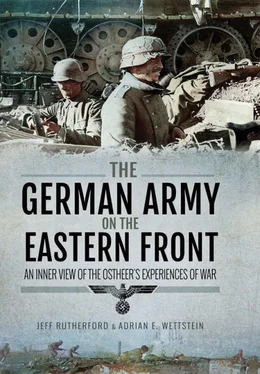Preparations for the destruction on the highway, rail road, and the Via’zma area takes place through the corps. The commander of Engineer Regimental Staff 517 is tasked with its preparation (Special Order).
The carrying-out of the destruction occurs on the order of the troop commander, in general the rear-guard (rear-guards) commander.
Orders for the demolition of especially important objects are to be given in writing to the explosive groups.
II. Destruction in the Main Defensive Area and in the Movement Corridors
1) With the beginning of the movement, the existing gaps in the obstacles in the main defensive area are to be closed, and the communication trenches and supply roads are to be blocked.
As long as they cannot be inconspicuously mined, pillboxes and combat installations are to be strewn with booby traps and mines.
2) To be destroyed in the movement corridors :
a) fountains
b) all larger and important bridging objects, especially those vitally important for supply traffic of the enemy in the muddy time. […]
c) heated halls, garages for vehicles, workshops.
d) command posts and troop camps, especially in the vicinity of the rail stations […]
e) supply installations including equipment and vehicles
f) other objects important for combat (hospitals, warehouses, etc)
Mines need to be scattered on all bridge by-passes of demolition objects and on all fords against tanks and trucks. […]
3) Destruction of Shelters
It begins with the withdrawal from the Ia-Line and is to be correspondingly carried out with the march movements.
The still remaining civilian population is to be consolidated into individual houses; that which is necessary for life is to be left for them.
Special commandos (ski troops off the street) are to be assigned for the carrying out of this destruction. The troops are to be correspondingly equipped with the necessary materials (matches, Molotov cocktails, etc). That is to be organized now.
4) Destruction of Material and Supply Goods
No weapon, no equipment, no supply goods can fall in the hands of the enemy.
The first principle is that all weapons (including captured weapons), all ammunition, especially scare munitions, are to be saved and sent away.
As long as ammunition cannot be evacuated, it is to be shot-off on enemy artillery, previously known assembly areas, etc. beginning immediately or to be used for the demolition of objects in the main defensive area.
As long as food stocks, fodder, etc. cannot be evacuated, a timely destruction is to be guaranteed (open potato clamps).
Ovens and stove pipes as well as windows are to be saved and delivered to the new position. There will be no new deliveries . […]
III. Destruction in front of ‘Buffalo’
A 15km deep desert zone is to be created forward of the ‘Buffalo’ position.
The population necessary for keeping the roads clear is to be consolidated in towns and villages during the course of the march. All remaining towns and villages are to be destroyed, beginning now (windows and wood for bunker construction). The burning down can be carried out with the beginning of the movement. The failure to do so in order that the troops marching through can secure shelter is forbidden .
The commanders of the fortification construction staffs are responsible for the destruction. They are to personally report in writing the complete destruction (with maps). […]
As the order indicated, scorched earth retreats were based on the notion of military necessity or, in other words, trying to ensure that the German army remained superior in the field to its Soviet counterpart. Anything that could benefit the on-coming Red Army was either to be destroyed – such as shelters, bridges, or installations – or dragged to the rear – such as weapons, food, and ammunition. Of particular note, the order made no mention of forcibly evacuating the civilian population, which later became an important component of scorched earth retreats; instead, it explicitly stated that civilians were to be left with enough food to live. How this was enforced is of course an entirely different issue, and depended on how the officer or NCO in charge interpreted how much food was needed for civilians’ survival and how much was required by the army for its tasks and even its perceived survival.
The defensive and positional warfare posture adopted by the army in the northern and central sections of the front is well captured by an entry in the 126th Infantry Division’s war diary from March 1943. [37]
I visited the 5th, 6th, 7th, 8th, and sections of the 13th and 14th companies of [Infantry Regiment] 426 and the deployed battalions of the 1st and 2nd [Mobile Battalion], the mounted rifle platoon 426, flak and the reconnaissance squadron. The combat position here lies in the middle of a swamp. With every step, one breaks through the thin covering of ice up to the knee. Elements of the men have absolutely no shelter and, wrapped in blankets, sleep during the day next to the machine gun as long as they do not have fatigue duty. At any moment, one must be prepared for a heavy artillery attack, which has repeatedly come on previous days. The battalion, which has repelled heavy Russian attacks and is well supported with anti-tank weapons, confidently looks forward to the coming weeks. The spring sun gives a new optimism despite the difficult circumstances.
Important elements of the German combat experience in the east are found in this passage. Soviet artillery superiority was a fact of life for much, if not all, of the German army from 1942 on, and the experiences of the 126th Infantry Division certainly fell into this general trend. The introduction of new weapons – such as the MG 42 or the 7.5cm ATG 40 – allowed the under-manned German infantry to even the odds against its Soviet opponent and this, in combination with the fact that Red Army attacks had been repeatedly repulsed over the course of two years on this section of the front, fed into the German army’s still meaningful confidence on the battlefield. Issues of terrain, however, had yet to be solved, and these plagued the army throughout the entirety of the campaign.
This defensive mind-set was even applied to the panzer divisions that had served as the foundation for Germany’s string of victories based on mobility and manoeuvre between 1939 and 1941. While his division was situated in the Polotsk-Vitebsk area, the 8th Panzer Division’s commander explained to his officers the unit’s role in early summer 1943: [38]
I. The situation of the army is clear. The army must hold its present position at all costs. The Russian has a particularly favourable spring board near us in order to achieve success. We cannot move back to the west under any circumstances. The Eastern Wall of our army must hold out against everything.
We need an Eastern Wall of men and it must be built to the utmost. […]
Every man must be clear and unambiguous about this understanding of the Eastern Wall.
The wall must be held at all costs by weak forces.
[…]
II. Much has already been written and spoken, but it has not yet been translated into action such as the army must demand. Many orders of the army have been perceived as meddling.
This is not as it should be.
The will is to be translated into action that is decisive.
A side effect of positional warfare is that details need to be ordered [from above]. Unfortunately, there are still commands in which the necessary vigour does not prevail.
Guidelines for all commanders to emphatically do this. Especially the weak ones must be exhorted to this end.
Carelessness will not be tolerated, for that reason alone we are poor [in men and equipment].
Читать дальше






![John Stieber - Against the Odds - Survival on the Russian Front 1944-1945 [2nd Edition]](/books/405234/john-stieber-against-the-odds-survival-on-the-russian-front-1944-1945-2nd-edition-thumb.webp)





